
Bahrain GP: Red Bull showdown, amazing podium for Alonso. Disappointment for Ferrari!
The showdown of Max Verstappen and his Red Bull RB19 on the Sakhir circuit was simply overwhelming. A race dominated from start to finish, practically never forcing, except - partially - in the first stint. A car that had an astonishing pace on both Soft and Hard tyres, managing to complete a couple of stints on the former with unapproachable lengths for anyone else. Here is the classification of the Grand Prix:
- Max Verstappen (Red Bull)
- Sergio Perez (Red Bull)
- Fernando Alonso (Aston Martin)
- Carlos Sainz (Ferrari)
- Lewis Hamilton (Mercedes)
- Lance Stroll (Aston Martin)
- George Russell (Mercedes)
- Valtteri Bottas (Alfa Romeo)
- Pierre Gasly (Alpine)
- Alex Albon (Williams)
- Yuki Tsunoda (Alpha Tauri)
- Logan Sargeant (Williams)
- Kevin Magnussen (Haas)
- Nyck de Vries (Alpha Tauri)
- Nico Hulkenberg (Haas)
- Zhou Guanyu (Alfa Romeo)
- Lando Norris (McLaren)
- Esteban Ocon (Alpine, DNF)
- Charles Leclerc (Ferrari, DNF)
- Oscar Piastri (McLaren, DNF)
The race of his teammate Sergio Perez, second placed at the finish line, was partially compromised by an unhappy start compared to Charles Leclerc's excellent clutch release, who immediately made good use of the set of new Soft tires saved in qualifying. Finding himself third, Perez spent just less than a half of the race behind Leclerc, on whom he had an easy time as tyre wear caused the Ferrari driver's performance to deteriorate. We will come back to the race of the Prancing Horse duo later…
On the third and final step of the podium, surprisingly until a couple of weeks ago, there’s Fernando Alonso (for the 99th time in his career!). The Asturian driver ran a race without mistakes and with an excellent pace, demonstrating how his Aston Martin AMR23 is currently the second fastest car in the World Championship behind Red Bull. This result, confirmed by the very good sixth place of Lance Stroll (with recently broken wrists), certifies the goodness of the work done during the winter by the team based at Silverstone.
"I want to congratulate Lance, my teammate, because he had to undergo surgery just 12 days ago and today he was there battling with us"
Fernando Alonso
The AMR23 currently has the lowest top speed as its only weak point compared to the 3 top teams (Red Bull, Ferrari, Mercedes): judging overall performance, however, starting from 2023 it is more correct to speak of 4 top teams.
In fourth place we find the first and only Ferrari of Carlos Sainz, given Leclerc's retirement on lap 41: the two SF-23s, up to the moment in which they were both in the race, exhibited a pace of about 0.8 s/lap slower than the Red Bulls, which weren't at the limit of what their car allowed. It didn't go any better for Carlos Sainz, who was passed by Fernando Alonso in the final stages of the race and who defended himself - only by virtue of a high top speed - from the attack of Lewis Hamilton, who eventually crossed the finish line in fifth.
The English driver, who preceded Lance Stroll (6th) and his teammate George Russell (7th) at the finish line, certainly had an excellent race: from this point of view, his Mercedes W14 showed better performances in the race than in qualifying. All this was achieved despite a really accentuated tyre degradation at the end of each stint!
Race analysis: how to understand the pecking order?
So let's analyze in detail the development of the race, completed by all the front runners on a 2 pit stops strategy. If most of the drivers chose, after a start on Soft tyres, to opt for two stints on Hard, the only (virtuous) exception is made up of the aforementioned Red Bull duo.
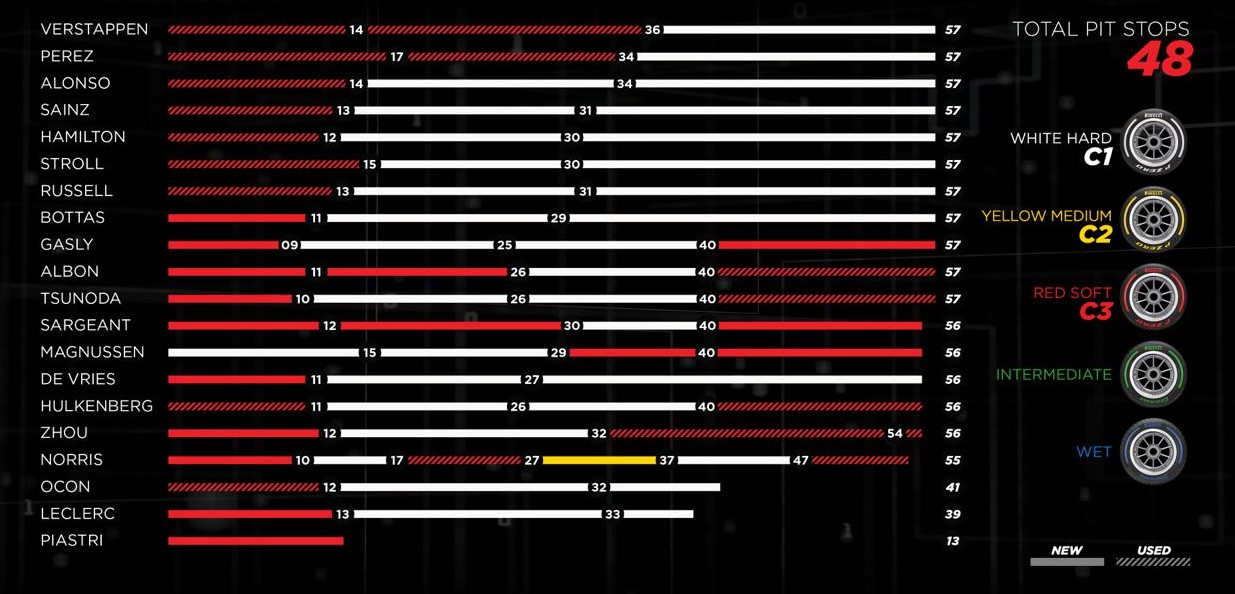
Such is the advantage of the English-Austrian team that it can afford a central phase of the race still on Soft tyres, whose performance usually declines within a few laps. This was not the case for Verstappen and Perez, who extended that stint until their opponents pitted for the second pit stop: at which point they covered for them by stopping on the next lap, although they could easily have extended the stint further.
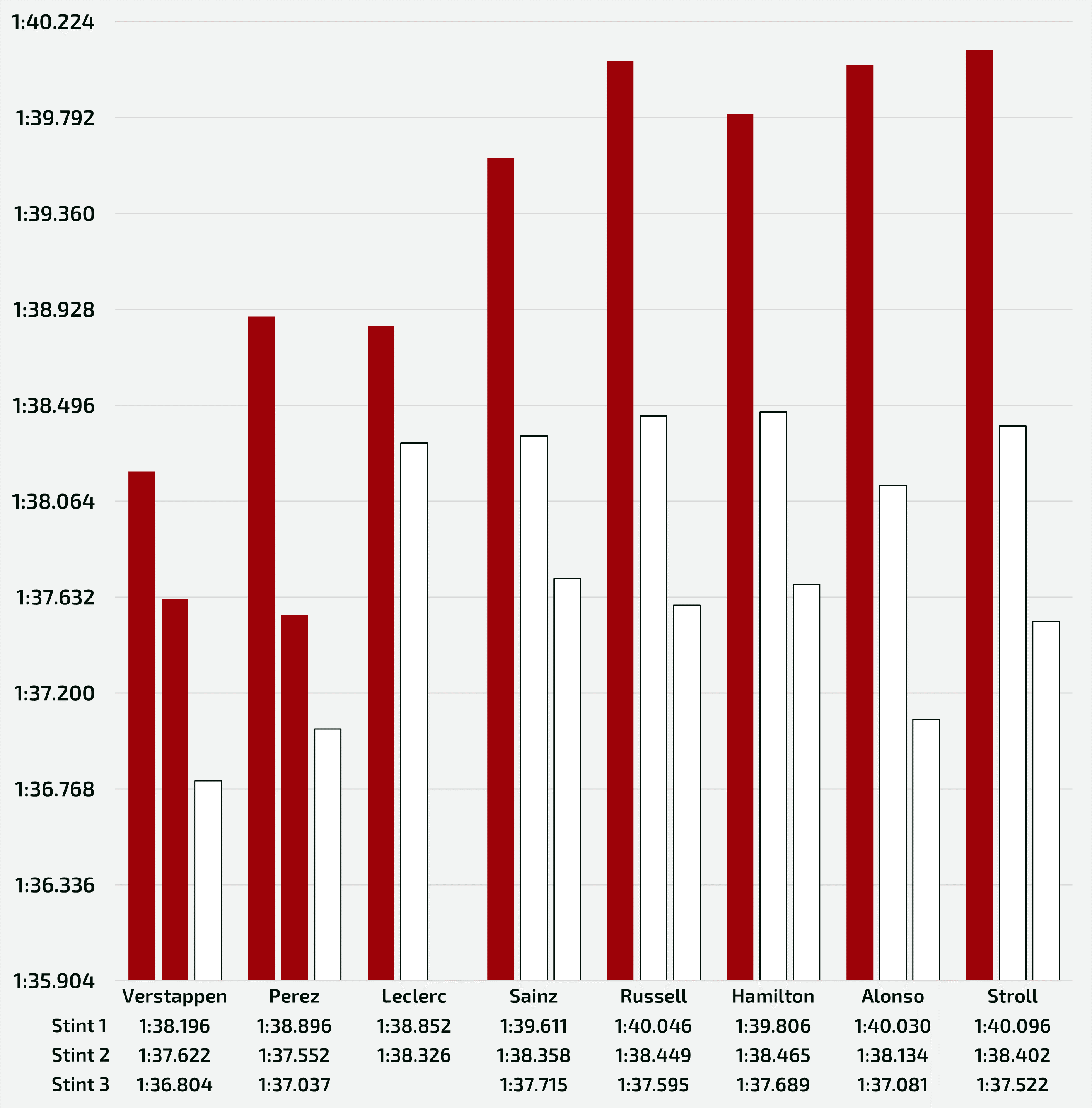
Given the high degradation endured by Ferrari and Mercedes, the performance showed by Alonso in the two periods on Hard tires is surprising, on average between 0.5 s/lap and 0.6 s/lap faster than the two teams mentioned. In terms of the final result, however, Fernando could not have done better than third place even if he hadn't lost time behind Hamilton and Russell in the opening laps. Alonso's start was not poor, but in turn 4 (while he was battling with Hamilton) he suffered a contact from his teammate Stroll, following a decidedly late braking by the latter!
The two historic rivals (Alonso and Hamilton) found themselves in a tussle further on in the race, when on lap 38 the former performed a spectacular overtaking on the latter, in a zone of the circuit - the difficult trail braking at turn 10 - where it is really rare to see such maneuvers. Passing Lewis, Fernando unleashed his speed catching the Ferrari driver Sainz, and passing him (this time in the traction zone exiting turn 10) on lap 46. From that moment on, he had no difficulty in pulling away from his two rivals, going to take a well-deserved third position.
"It has been a truly great weekend for the team and finishing on the podium in the first race of the season is extraordinary. The work Aston Martin has done over the winter has been incredible and we ended up with the second best car at the first weekend. It's really unreal"
Fernando Alonso
Hamilton, for his part, at the end of the race had a better pace than Sainz, but his lower top speed on the straight prevented him from carrying out a concrete attack on Carlos in the last 10 laps, guaranteeing him a fifth place that was certainly unsatisfactory for him, but all in all positive for Mercedes given the expectations after the qualifying session.
"The problem isn't the tyres, it's the car. In general, the race pace seemed the same to me as last year. This morning, when we made the strategy, I told the guys that it wouldn't go as well as they thought, and in fact, it didn't go like this. We still have a lot of work to do. We need to add downforce to the car, we really need a lot. As soon as we put more load on the rear and front, our pace will certainly be better"
Lewis Hamilton
How would it have ended between Leclerc and Alonso without the DNF of the Monegasque?
The most important twist of the Grand Prix was undoubtedly Charles Leclerc's early stop on lap 41, apparently caused by components related to the electrical part of the Power Unit (ERS and battery pack according to Formu1a.uno colleagues). The engineers from Maranello were most likely aware of the possibility of a similar problem, as before the race they had changed the Electronic Control Unit and Battery Pack on the Monegasque's SF-23. But this was not enough, and the components causing the failure cannot be recovered in the next GPs.
It seems incredible to say this, but on the eve of only the second Grand Prix, Leclerc is already at risk of grid penalties should he use the third unit (only 2 are allowed in the season) as regards the Electronic Control Unit or the Battery Pack!
"We weren't fast in the race compared to Red Bull and we need to talk about them because that's our goal. In terms of performance in the race, we weren't there this weekend. We have to make progress from this point of view, we're too far away. Red Bull must have found something because you've never seen cars so close in qualifying which then gives a second per lap in the race"
Charles Leclerc
Having said of Charles Leclerc's retirement while he was in third position behind Verstappen and Perez, it is questionable whether he could have defended the podium from the comeback of Fernando Alonso and his Aston Martin.
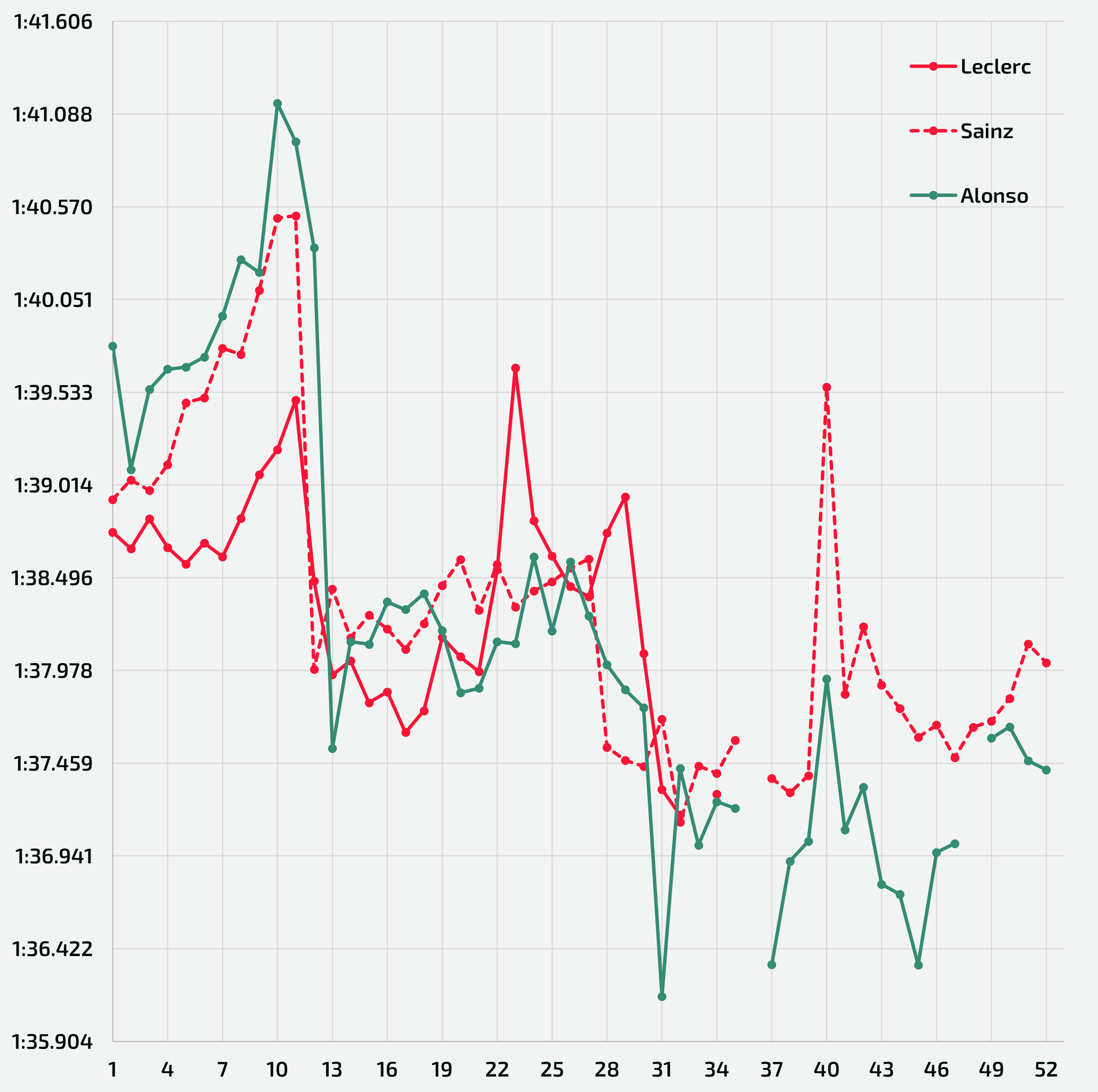
The laptime charts of the two Ferraris and the Spanish driver of Aston Martin suggest not. When Charles retired, he was 9.2s ahead of his teammate; at the finish line, third-placed Alonso and fourth-placed Sainz were separated by almost 10 s, so there was probably room for Fernando to make up ground on Leclerc. Making this type of assessment is certainly a gamble, because we don't know how much of their potential everyone was putting on the track, but on the other hand the difficulty encountered by the two Ferrari SF-23s on the rear tires is a matter of fact: I therefore believe that Leclerc, despite having the ability to force more to prevent Alonso from rejoining, could not have pushed for many consecutive laps before an important performance drop…
"What we see is that the others can push harder in the race. On the flying lap the car is not where we want to be, because Red Bull is still two tenths faster, but in the race the others can push and we have to manage the tires We have to pay a lot of attention to the degradation of the rears. We have to go home, look at all the data and understand what we can do to improve, because we don't have much margin in the race"
Carlos Sainz
Indeed, a bit like Carlos Sainz, I am of the opinion that Charles' final race time would have been even worse in the event of forcing to contain Fernando's comeback!
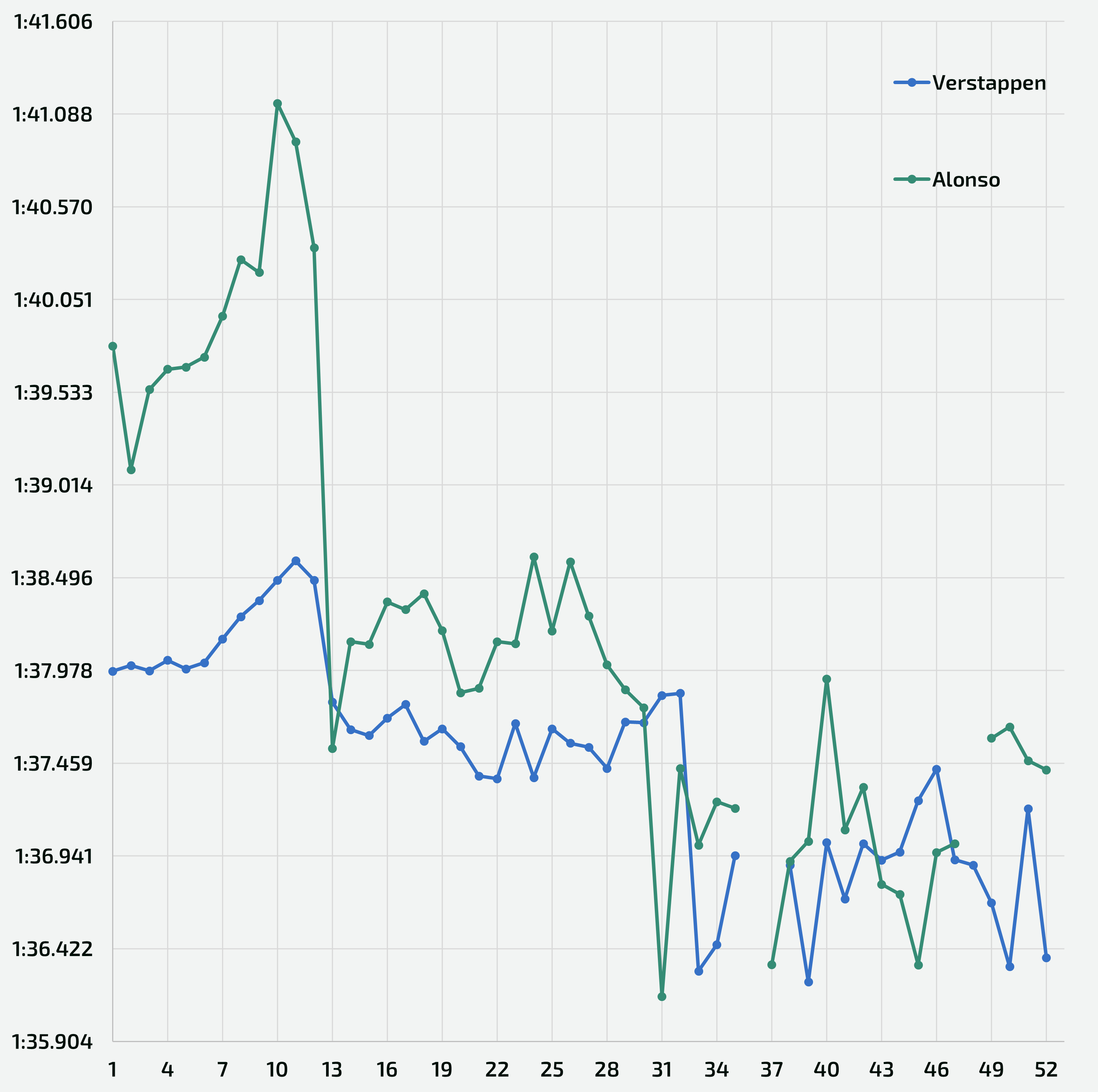
The performance comparison, in fact, lets us understand quite clearly the reliability of this scenario: Alonso's last stint was close to Verstappen's time, while - as can be seen from the graph below - throughout the portion of the race carried out by Leclerc, the same #16 driver was faster than Max in just three or four laps. An abysmal difference in competitiveness.
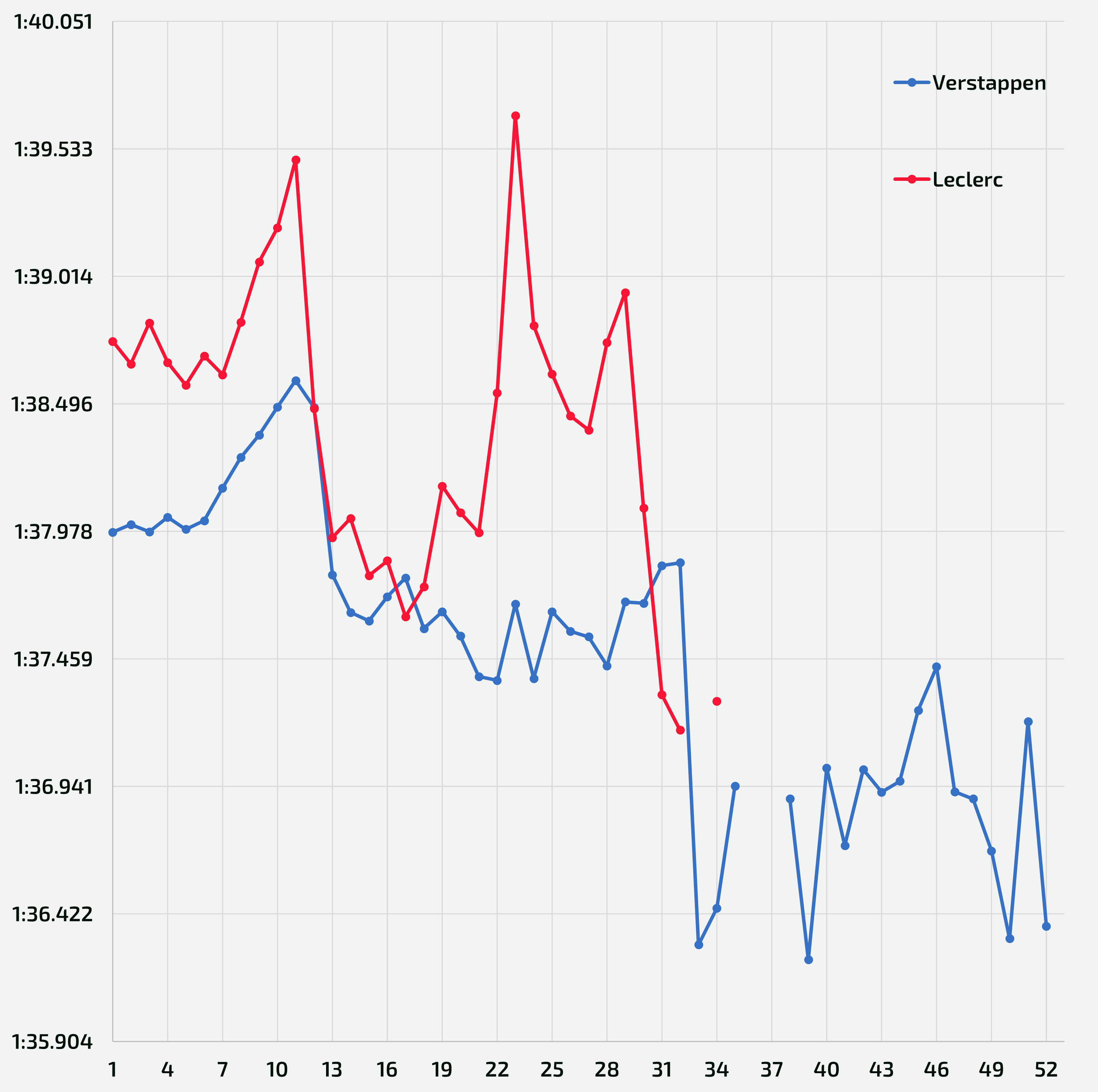
General performance, fastest laps and a few words about the midfield
If we look at the personal fastest laps achieved by each driver in the race, the picture expressed so far is once again confirmed. The only "out of place" data, if we want to say so, are the very fast laptimes obtained by Gasly (Alpine), Norris (McLaren) and Zhou (Alfa Romeo), who also set the absolute fastest laptime in 1:33.996. The unreliability of these values simply lies in the fact that the above times are the result of alternative strategies, with pit stops carried out under the Virtual Safety Car or at the end of the race.
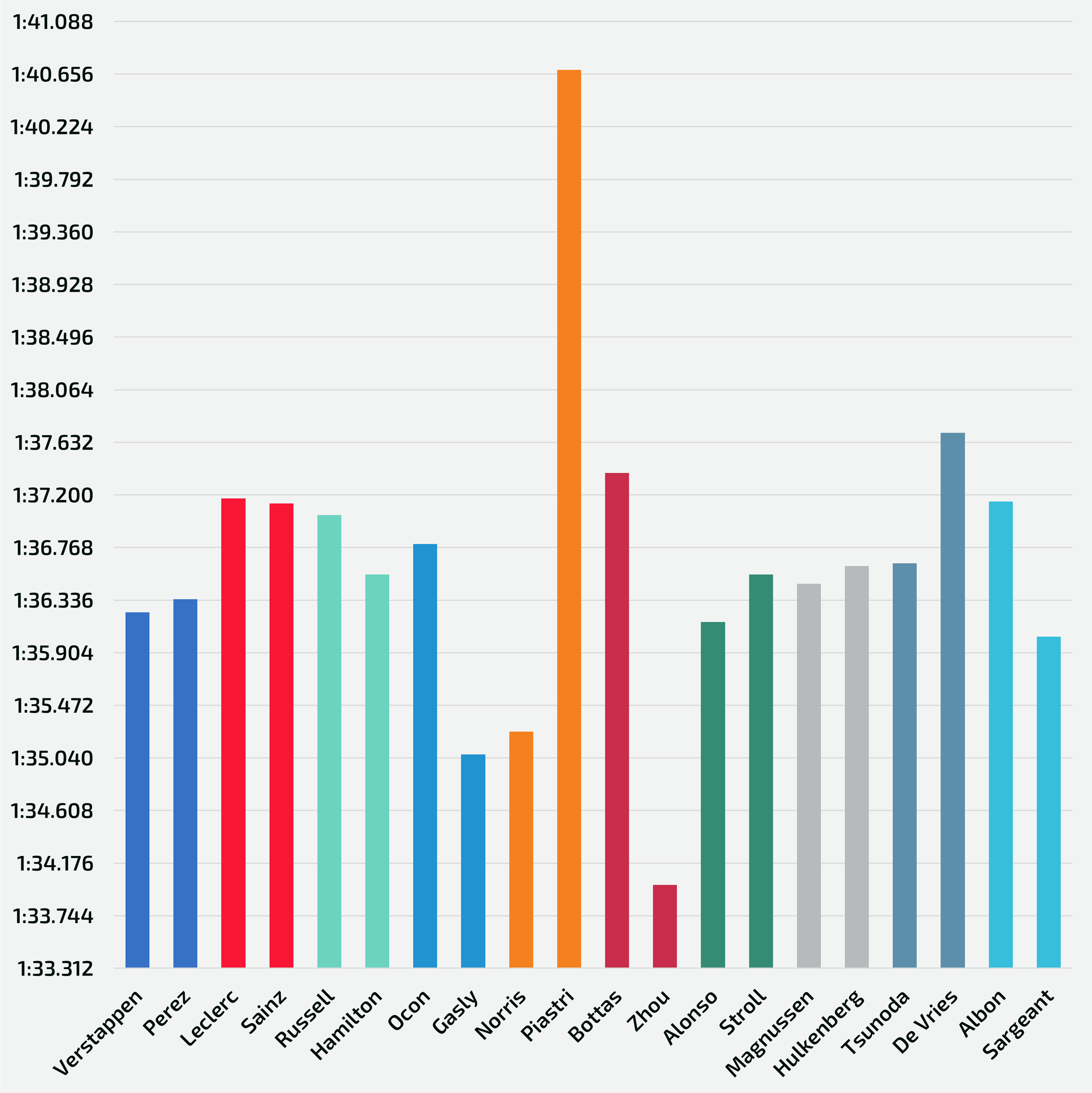
Analyzing the performance of the midfield net of the above, Gasly's comeback from last starting position to ninth at the end of the race is relatively striking: the recovery itself was exceptional, but actually Alpine has far more ambitious goals than collecting a couple of points. To achieve these objectives, much more will be needed from the Enstone team, with updates that will have to give overall more speed to an A523 that is very far from even its 2022 standards.
The best result behind the 4 top teams however goes to Bottas, who with his Alfa Romeo C43 benefits from an excellent start and a race ran away from brawls and any inconvenience that could have caused him to lose precious race time. Four points that will certainly leave him satisfied, as he simply could not have done more than that!
The real surprise, however, is Williams: in the analysis of the preseason testings I had predicted the Grove team as ending up at the back of the group, but the performances of Albon (10th) and rookie Sargeant (12th) definitely made me change my mind. The doubt remains whether the good result was helped by a rear-limited track configuration, but in two weeks' time, in Jeddah, we will have some counter-tests.
What to expect at the next GP in Saudi Arabia?
The next round of the 2023 Formula 1 World Championship is then in Jeddah, Saudi Arabia. Top speeds will be very important there, so I expect (aside from a still dominating Red Bull) a battle between Ferrari and Aston Martin which will go mainly in Maranello direction.
As always, if you found this article interesting, please share it! I also remind you that I'm active on Instagram and Twitter to discuss Formula 1 live. See you next time!
Index
Bahrain GP: Red Bull showdown, amazing podium for Alonso. Disappointment for Ferrari!